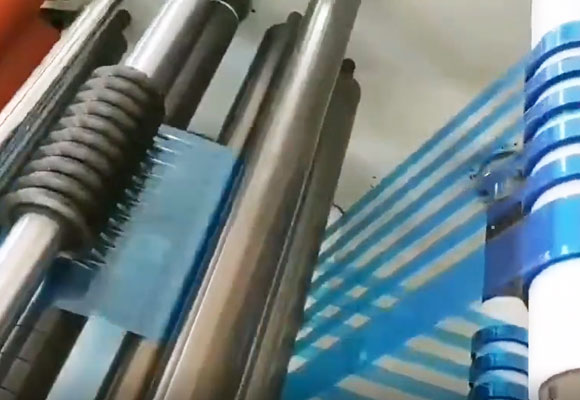
Slitter Rewinder: What Is It & How Does It Work?
A slitter rewinder, also known as a slitter machine, is a crucial machine used in the converting industry that can efficiently cut or convert large rolls of material into required sizes. In this article, we will discuss more about slitter rewinders: the definition, applications, processes, and slitter rewinder knives.
What is a slitter rewinder?
A slitter rewinder is a machine designed to cut large rolls (named parent rolls or master rolls) of material into narrower rolls for further steps of production. Slitter machines are mainly used in the converting industry. The converting industry refers to transforming flexible packaging materials into other forms of finished products. Flexible packaging materials include thin film, foil, plastic, and paper, just to name a few. Generally, a slitter rewinder is used to cut a specific type of material, but it can also be changed to cut other types of materials.
A slitter rewinder mainly comprises three sections. The first step is to unwind the master rolls at a high speed. When the rolls are unwound, they will be cut into the required widths by slitter rewinder knives. Then, the workpiece is rewound again in a narrower width. As for the slitting part, there are three types of slitting methods: razor slitting, rotary shear slitting, and score slitting. We will discuss them later.
The work of slitter rewinders is everywhere in our daily life. For instance, tissue rolls and receipts both come from very large rolls before the converting process.

Applications
Apart from thin films, foils, plastics, and paper, slitter rewinder machines can also be used to slit polymer, polyester, fabric, and almost any other ultra-thin flexible material. Here is a list of materials that can be slit by a slitter rewinder: tape, textile, geotextile, natural fabric, film, foil, foam, plastic, paper, rubber, woven&non-woven, PVC, felt, and more.
How does a slitter rewinder work?
The basic operation of a slitter rewinder can be divided into three sections: the unwind section, the slitting section, and the rewind section.
- Unwind
The master roll is mounted onto a shaft and then it is placed into position and fed through the machine for unwinding.
- Slitting
Once the workpiece is unwound, it is fed into the slitting section and is slit into narrower widths by circular dished knives. The number of knives depends on the number of strips required.
- Rewind
When the workpiece is cut into strips with smaller widths, it is then rewound into individual rolls. This section comprises several rollers that are used to guide the workpiece. The tension can be adjusted to ensure that the smaller rolls are rewound evenly and tightly.
Types of slitting
As we mentioned above, all slitting machines work in the same process of unwinding, slitting, and rewinding, but they differ in slitting methods. There are three types of slitting methods: score slitting, razor slitting, and shear slitting. The selection of the slitting method mostly depends on the material of the workpiece.
- Score slitting
Score slitting refers to cutting the workpiece between a rotary slitting knife and a hard surface. It is ideal for slitting adhesives such as sticky tape. Score slitting is affordable and easy to install, but it is not suitable for many other materials such as paper and film due to the risk of causing stretching and cracking.
- Razor slitting
Razor slitting is ideal for slitting thin materials like paper, film, and foil. It is less expensive than the other two methods. By using industrial razor blades that are mounted on the slitting holders, razor slitting can efficiently and cleanly convert these materials into required widths. However, razor slitting is not ideal for cutting abrasive or heavy materials, as the blade may heat up and damage the workpiece.
- Shear slitting
Shear slitting is more versatile and accurate than the other two methods. Similar to the operating principle of a pair of scissors, shear slitting uses a pair of rotating circular blades to simultaneously cut the workpiece from above and below. The blade above the workpiece is called the dished top knife, and the blade below is the bottom knife. Shear slitting is suitable for converting thicker or heavier materials like rubber and laminates.
Automation
Some slitting machines are fully automated, whereas some are not. The level of automation can significantly impact the uniformity and precision of the results. Fully automated slitter rewinders can automatically complete the entire process, from feeding to unloading. High-level automated slitting machines are also equipped with outstanding features like interchangeable blades, resulting in excellent accuracy and consistency. Even semi-automated slitter rewinders are much superior to manual machines. Thus, it is advisable to select a slitting machine with the right level of automation that suits your budget and needs.
Knives for slitter rewinders
Slitting knives are crucial to the slitting process. By using the right blades, we can obtain accurate and clean cuts. Konetool has solid experience in the manufacturing and supply of carbide dished knives for slitter rewinders. We adhere to strict standards in the manufacturing process to ensure product quality. Our dished knives are made from 100% WC powder, featuring excellent performance and durability. If you need further information about our dished knives, please request a quote. Our salespeople are ready to provide tailor-made services for you.

